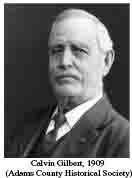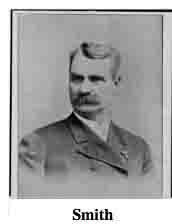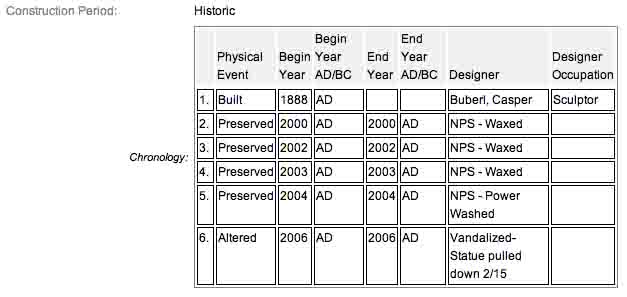
This nice examples of the 10-ponder Parrott rifle is in terrific shape: its limber, carriage, barrel and all other things weaponry are in terrific condition. These rifles are rarer than the 3-inch ordnance rifles & the Napoleons which dominate the Park. The Parrot is very similar to the 3-inch ordnance save for the band around the breech which distinguishes itself from the 3-inch ordnance. Also, some Parrotts have a flare at the end of the muzzle (eliminated in 1863) and the 3-inch does not. Another similarity is the deep incised, identification stamp running along the outer muzzle. Sometimes stamping appears on the trunnions. On the proper right trunnion the stamp reads R.P.P., which are the initials of Captain Robert Parker Parrott, the inventor of the Parrott Rifle. The proper left trunnion's stamp reads 10 PDR which of refers to the weight of the projectile ordnance. A stamp sometimes appears at the top of the breech which reads: 3. IN. BORE. The bore was not enlarged to a 3-inch size until 1863 so that bit of information at least acts as an identifier. Curiously however, this Parrott rifle does not have any identifying marks. As a result, this guns is anonymous as I could not recover the registry or foundry numbers.
The manufacturing of the gun carriages is an interesting story. After the war, Calvin Gilbert conducted a foundry @ Gettysburg and manufactured metal gun carriages to replce the rotted wooden ones. He also cast the battery tablet at this site as well as the other ones about the battlefield. Gilbert joined the 87th Pennsylvania Volunteers when the "Rebellion" broke out. Since he was musically inclined, he was made a member of the regimental band. In early 1863, he was promoted to the rank of Captain and sent to Washington D.C. for commissary duty. He served in that capacity until the war ended in 1865, and at war’s end earned the brevet rank of Major.  After returning home to Gettysburg, Major Gilbert moved his family to the town of Chambersburg, where he served as the Superintendent of Schools. He also opened an iron foundry there in 1868. When Calvin learned, nearly thirty years later, in 1894, that the Gettysburg Foundry was available, he purchased it with a business partner & moved his family back to Gettysburg. For the next twenty years, the Calvin Gilbert Foundry created ironworks that are still seen today on many historic forts and national battlefields (this tablet), from upstate New York to Florida to Lookout Mountain. Gilbert lived to be 100 years old and attended the Last Reunion of the Blue and Gray for the 75th anniversary of the Battle of Gettysburg when he was 99. He was a most remarkable man who lived an amazing life.
After returning home to Gettysburg, Major Gilbert moved his family to the town of Chambersburg, where he served as the Superintendent of Schools. He also opened an iron foundry there in 1868. When Calvin learned, nearly thirty years later, in 1894, that the Gettysburg Foundry was available, he purchased it with a business partner & moved his family back to Gettysburg. For the next twenty years, the Calvin Gilbert Foundry created ironworks that are still seen today on many historic forts and national battlefields (this tablet), from upstate New York to Florida to Lookout Mountain. Gilbert lived to be 100 years old and attended the Last Reunion of the Blue and Gray for the 75th anniversary of the Battle of Gettysburg when he was 99. He was a most remarkable man who lived an amazing life.
There is an excellent excerpt in the American Guide Series about Gilbert attending the 75th reunion anniversary.

This rifle is located on the straightaway portion of Sickles Road that comes out of the serpentine section which wraps its way to the top of Devil's Den. This rifle is on the right or east side of the road if traveling north. The  Robertson's Brigade Advance Position Marker is directly across the road, lined up with the muzzle of this rifle. There are four artillery pieces which flank the monument, two 10-pounder Parrott rifles on either side. If facing the monument, this rifle is to the far left of the monument. Parking is available up here at large shoulder areas on the right side of the road. Take care to not park on anything remotely green looking as Park Police will happily ticket you. I visited this site on Monday, July 1, 2013 on the 150th anniversary of the Battle of Gettysburg @ 4:17 PM, EDT & @ an altitude of 557 feet, ASL. As always, I used my trusty and oft abused Canon PowerShot 14.1 Megapixel, SX210 IS digital camera for the photos.
Robertson's Brigade Advance Position Marker is directly across the road, lined up with the muzzle of this rifle. There are four artillery pieces which flank the monument, two 10-pounder Parrott rifles on either side. If facing the monument, this rifle is to the far left of the monument. Parking is available up here at large shoulder areas on the right side of the road. Take care to not park on anything remotely green looking as Park Police will happily ticket you. I visited this site on Monday, July 1, 2013 on the 150th anniversary of the Battle of Gettysburg @ 4:17 PM, EDT & @ an altitude of 557 feet, ASL. As always, I used my trusty and oft abused Canon PowerShot 14.1 Megapixel, SX210 IS digital camera for the photos.
About the Foundry
As far as I know, these rifles were made exclusively here in 1863. The West Point Foundry was an early ironworks in Cold Spring, New York that operated from 1817 to 1911. Set up to remedy deficiencies in national armaments production after the War of 1812, it became most famous for its production of Parrott rifles and other munitions during the Civil War, although it also manufactured a variety of iron products for civilian use. The rise of steel making and declining demand for cast iron after the Civil War caused it to gradually sink into bankruptcy and cease operations in the early 20th Century.
In 1835, Captain Robert Parker Parrott, a West Point graduate, was appointed inspector of ordnance from the foundry. The next year, he resigned his commission and on October 31, 1836 was appointed superintendent of the foundry. It prospered under his tenure, and was the site of numerous experiments with artillery and projectiles, culminating in his invention of the Parrott rifle in 1860. During Parott's tenure, in 1843, the foundry also manufactured USS Spencer, a revenue cutter which was the first iron ship built in the U.S. The foundry's operations peaked during the Civil War due to military orders: it had a workforce of 1,400 people and produced 2,000 cannon & three million shells. Parrott also invented an incendiary shell which was used in an 8-inch Parrott rifle (the "Swamp Angel") to bombard Charleston. The importance of the foundry to the war effort can be measured by the fact that President Abraham Lincoln visited & inspected it in June 1862.
SOURCE
About the Gun
The most common rifled field artillery piece in Civil War service was the 10-pdr. Parrott . The first Parrott Rifle (and corresponding projectile) was created in 1860 and patented it in 1861. SOURCE This Parrott design went through several improvements during the war. The U.S. M1863 10-pounder Parrott was slightly modified from the M1861 pattern; the bore was increased to 3.0 inches in 1863 with a matching Parrott shell, to make its ammunition consistent with that of the new 3-inch ordnance rifle, and the muzzle swell was eliminated. By 1864 the 3-inch Parrott was standardized & most of these 2.9-inch guns were withdrawn from service. Parrotts were manufactured with a combination of cast iron & wrought iron. The cast iron made for an accurate gun, but was brittle enough to suffer fractures. On the Parrott, a large wrought iron reinforcing band was overlaid on the breach. Although accurate, the Parrott had a poor reputation for safety & they were shunned by many artillerists.
The Antietam Battlefield people placed a small identification marker next to one of their Parrotts which reads:
10-POUNDER PARROT RIFLE
The cast iron rifle with its band of wrought iron reinforcing
the breech was a modern weapon of the day. It was effective at
moderately long range. The 20-pounder, similar except for size,
was the heaviest rifled cannon used at Antietam.
Confederate versions of the Parrott rifles were built by the Noble Brothers Foundry, the Macon Arsenal in Georgia and Tredegar Iron Works in Richmond, VA. Confederate cast Parrott rifles used seven hook-slant or "Brooke" type rifle grooves, and can be identified by the taper on the trunnion side of the reinforcing band.
One of the pages of the Historical Marker Database also provided some interesting and corroborating facts about this weapon and history about the rifle: This 3-inch Parrott Rifle was produced at West Point Foundry in 1864, well after the battle. At the battle, the Parrott Rifles on the field were actually 2.9-inch bore models, commonly called 10-pounder Parrotts. Problems arose with logistical support, since similar shells were made for the 3-inch Ordnance Rifles. The Army opted to replace all 2.9-inch weapons with the slightly larger bore, and West Point began producing "new" Parrott rifles with 3-inch bores.
About the Battery
 The 4th New York
Independent Battery served as a member of Randolph’s Brigade in Third Corps, Army of the Potomac. The battery was commanded by Captain James E. Smith (1832 - 1893). Initially, the Fourth New York Independent Battery of Light Artillery was recruited and organized in New York City by Smith, who had previously served as a lieutenant in Varian's Battery, which was attached to the Eighth New York Militia. This battery - Varian's - enlisted April 19, 1861, for three months, & went to the front immediately. On its return some of the men re-enlisted under Captain Smith. Smith was a livestock merchant in New York City. In 1892 he published a history of his battery titled "A Famous Battery and its Campaigns 1861-1864, Fourth New Independent Battery". He is buried in Arlington National Cemetery.
The 4th New York
Independent Battery served as a member of Randolph’s Brigade in Third Corps, Army of the Potomac. The battery was commanded by Captain James E. Smith (1832 - 1893). Initially, the Fourth New York Independent Battery of Light Artillery was recruited and organized in New York City by Smith, who had previously served as a lieutenant in Varian's Battery, which was attached to the Eighth New York Militia. This battery - Varian's - enlisted April 19, 1861, for three months, & went to the front immediately. On its return some of the men re-enlisted under Captain Smith. Smith was a livestock merchant in New York City. In 1892 he published a history of his battery titled "A Famous Battery and its Campaigns 1861-1864, Fourth New Independent Battery". He is buried in Arlington National Cemetery.
At the July 1863 Battle of Gettysburg his battery, consisting of six 10-pound Parrott guns, was posted on ridges above the Devil's Den area, looking over what would be called the "Triangular Field". Here, on the second day of the engagement (July 2, 1863), Captain Smith directed his guns as they fought to repulse the Confederate attack of General James Longstreet's Corps. Under Smith's command, the battery brought 135 men to the field and among them, 2 men were killed, 10 wounded & one man went missing as well as there being 11 horses killed.
The monument marks the position and actions of the 4th N.Y. Independent Battery on July 2, 1863 reads as follows:
 (Front): 4th New York
(Front): 4th New York
Ind'p't Battery
(Smith's)
Artillery Brigade
3rd Corps
July 2, 1863 2 to 5 p.m.
(Back):Casualties
2 killed - 10 wounded
1 captured
At the time of the assault
by Hood's Division of the
Confederate Army this
Battery supported by the
Fourth Maine Infantry,
formed the extreme left
of the Third Corps line
three guns of the two sections
in action on this crest were
captured by the Confederates.
The third section was in
position to the right and
rear and continued the action
until nearly 6 p.m.
The rifles (incorrectly called cannons) are also identified in the NRHP nomination and narrative form which can be found below.
From the Nomination Form:
Marks position taken by 4 guns of Smith's 4th New York Battery on July 2, 1863 when outflanked on left & forced to abandon 3 guns on field. 1 of 90 mns in Park to NY commands in Gettysburg. Located on Sickles Ave at Houck's Ridge above Devil's Den. Pos. marker on Hancock Av.
Short Physical Description:
Mn, 2 flank markers & 4 wrought-iron cannons. Rough hewn gran. double base 6'9" sq; granite shaft 2'x2', topped w/ bronze artilleryman. All 12' high. Bronze State seal, corps insignia & text tablet, 2'2"x2'6" on W. Bronze tablet, 2'4"x1'5" on E. Flank markers, 1'x1'x1'3".
Four wrought-iron cannons are ten-pound Parrott rifled cannon on cast-iron carriages.
Long Physical Description:
2008 - Only the two cannon to the south of the monument remain. [all four rifles are now here as of 7 1 2013 - MT]
Bronze Artilleryman pulled down by vandals late in the evening of February 15 or early in the morning of February 16, 2006. Causing an estimated $30,000+ in damages.

My Sources
1.
NRHP Nomination Form
2.
SIRIS
3.
Stone Sentinels
4.
Virtual Gettysburg
5.
Draw the Sword
6.
Historical Marker Database
7.
New York State Military Museum